White Clover
Legume
(Trifolium repens)
White clover is a valuable and versatile legume widely used in the UK. The key to white clover’s survival and productivity is its multi-branched creeping stem, called a stolon which provides sites for new leaves, roots and flowers. The stolon stores carbohydrates and proteins meaning that the plant can overwinter and regenerate in the Spring. There are three stages of white clover growth from germination to full establishment. The rosette phase where the plant is reliant on a central taproot with a few branches and a small spread. The stage lasts around 3 months and the plant does not fix any nitrogen. It is important to graze at this stage to promote growth.
In the expansion phase the plant is reliant on the central tap root and there is rapid expansion of up to 15 branches. The initial rooting is poor on the stolons and careful management is key to avoid damage. 12 months post sowing the tap root starts to die and only now does nitrogen fixation begin.
In the clonal phase there is no taproot and the plant is reliant on adventitious roots which form at the nodes of the stolons and the clover is actively fixing nitrogen. The stolons will last 12-18 months when new stolons are produced at the terminal bud which then become independent plants and the cycle begins again.
Swards with an inclusion of clover will have an increased herbage quality with a D value typically two to three points higher under grazing. This will lead to higher dry matter intakes in the summer and autumn and combined with reduced inputs with white clover able to fix 100-150kg/ha of nitrogen per year.



































































